Introduction to heating cooling temperature control system of fermentation tank

In the pharmaceutical and biochemical industry, the fermentation tank needs to be equipped with a heating, cooling and temperature control system to control the temperature in the system. The LNEYA refrigeration, heating, cooling and temperature control system realizes the internal temperature control through the external connection of the fermentation tank.
Because the temperature of the fermentation tank has a great impact on the fermentation process, in addition to the direct relationship, humidity also affects the physical and chemical properties of the reaction solution, such as the viscosity of the reaction solution, the solubility and transfer rate of the substrate and oxygen in the reaction solution, the decomposition and absorption rate of some substrates, the kinetic properties of fermentation and the biosynthesis of products.
The fermentation temperature of the fermentation tank is not only applicable to the growth of bacteria, but also to the synthesis of metabolites. It changes with the type of microorganism, composition of culture medium, conditions and growth period. During the whole fermentation process, not only a culture temperature should be selected, but also different culture temperatures should be selected according to different stages of fermentation.
In actual production, because of the large volume of fermentation liquor and the temperature that is difficult to be raised, the more appropriate temperature of culture is often selected during the whole fermentation process to make the yield better, or adjust it appropriately under possible conditions. The growth stage should choose a more suitable growth temperature, and the product secretion stage should choose a more suitable production temperature.
The fermentation temperature needs to be controlled, and then it needs to be measured first. The fermentation temperature can be detected by thermometer or automatic recording equipment, and adjusted by using cold water, hot water or heat transfer oil into the fermentation tank jacket or coil.
In industrial production, generally used large fermentation tanks do not need to be heated during the fermentation process, because the fermentation releases a large amount of fermentation heat. In this case, cooling is usually required. Use automatic control or manual control valve to heat the low-temperature medium of the refrigeration circulator to connect the jacket or coil, and cool and maintain constant temperature fermentation through the heat exchange principle.
Raccomandazioni correlate
-
Efficient operation of high and low temperature integrated machine
1147To ensure more efficient operation of the high and low temperature integrated machine, you should select the appropriate type of equipment and solve the problem in time. The selection of high and low temperature integrated machines requires some p...
Visualizza i dettagli -
Refrigeration principle of LNEYA glycol chiller system
923Glycol Chiller System SUNDI -10℃ ~ 200℃, as we can tell from its name, it is to use Glycol as the refrigeration agent for the chiller.In the all air environment, because of the low temperature in the outdoors, it is impossible to use a cooling to...
Visualizza i dettagli -
Fault Hint of Cryogenic Chiller Refrigeration System
897When the high and low pressure of the system are higher than normal, there is usually air or excessive refrigerant in the system. At this time, we need to re-vacuum, and then add a proper amount of refrigerant to solve this problem. But there are ...
Visualizza i dettagli -
Ispezione di manutenzione dei gruppi frigoriferi a bassa temperatura
1062Le unità di refrigerazione a bassa temperatura devono solitamente essere sottoposte a manutenzione. Dopo la manutenzione, non è facile che si guasti e ci saranno più mercati. Se non è facile che si guasti, non smetterà di funzionare, il che equivale a salvare la com...
Visualizza i dettagli
 Refrigeratori industriali LNEYA Produttore Fornitore
Refrigeratori industriali LNEYA Produttore Fornitore













